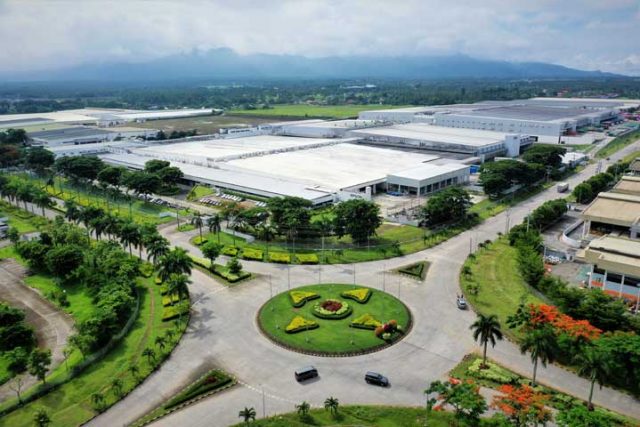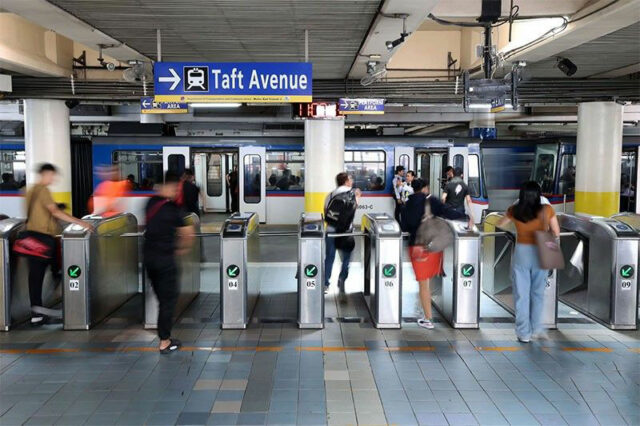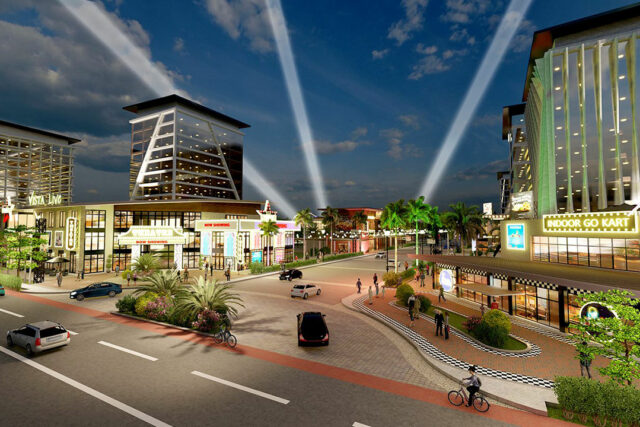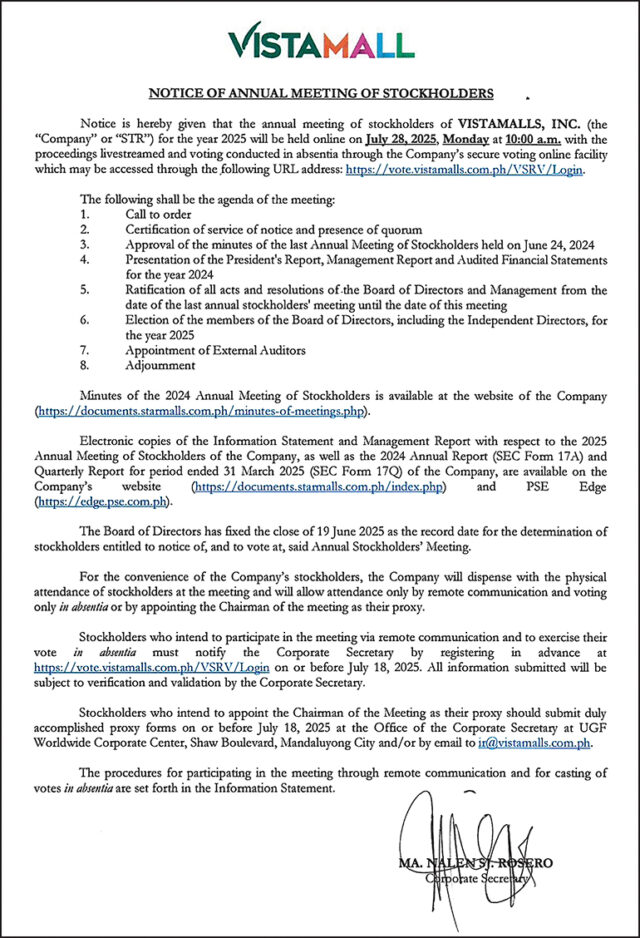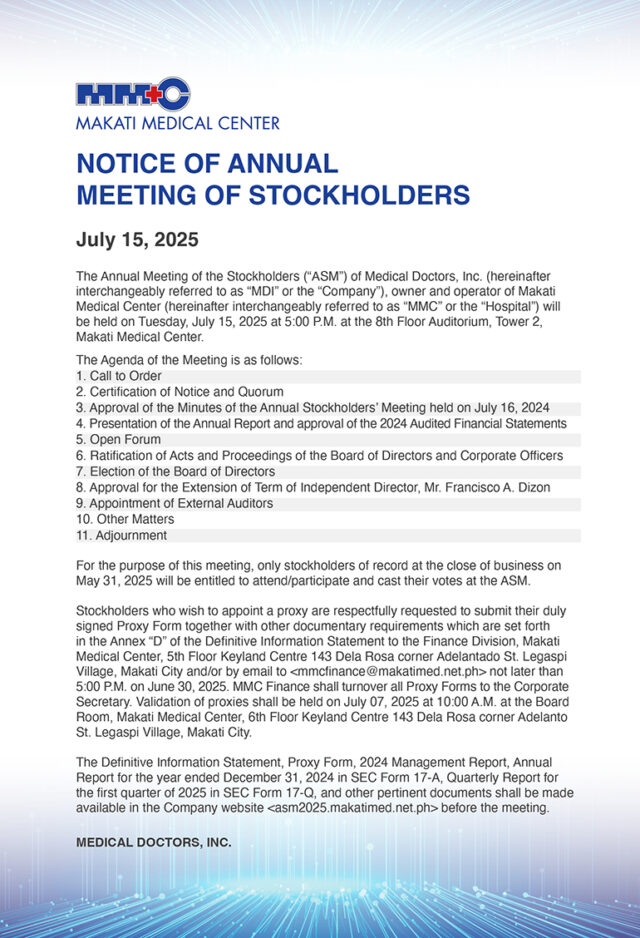Mouthwash may cure ‘the clap’
PARIS — In the 19th century, before the advent of antibiotics, Listerine mouthwash was marketed as a cure for gonorrhoea. More than 100 years later, researchers said Tuesday the claim may be true.
Fed keeps rates steady but pencils in two cuts by end of 2025

WASHINGTON – The US central bank held interest rates steady on Wednesday and policymakers signaled borrowing costs are still likely to fall in 2025, but Federal Reserve Chair Jerome Powell cautioned against putting too much weight on that view, and said he expects “meaningful” inflation ahead as consumers pay more for goods due to the Trump administration’s planned import tariffs.
“No one holds these … rate paths with a great deal of conviction, and everyone would agree that they’re all going to be data-dependent,” Powell said in a press conference after the end of a two-day US central bank meeting where policymakers slowed their overall outlook for rate cuts in response to a more challenging outlook of weaker economic growth, rising joblessness, and faster price increases.
If not for tariffs, Powell said, rate cuts might actually be in order, given that recent inflation readings have been favorably low.
But a cost shock is coming, he insisted, with producers, manufacturers and retailers still involved in a complicated struggle over who will pay the levies imposed so far, and President Donald Trump still contemplating an aggressive set of import duties that could go into effect early next month.
“Everyone that I know is forecasting a meaningful increase in inflation in coming months from tariffs, because someone has to pay for the tariffs … between the manufacturer, the exporter, the importer, the retailer,” Powell said. “People will be trying not to be the ones who can pick up the cost. Ultimately, the cost of the tariff has to be paid, and some of it will fall on the end consumer.”
“We’ll make smarter and better decisions if we just wait a couple of months or however long it takes to get a sense of really what is going to be the pass-through of inflation” from the higher import taxes, Powell said.
In new economic projections released alongside the Fed’s statement, policymakers sketched a modestly stagflationary picture of the economy, with growth in 2025 slowing to 1.4%, unemployment rising to 4.5%, and inflation ending the year at 3%, well above the current level.
While policymakers still anticipate cutting rates by half a percentage point this year, as they projected in March and December, they slightly slowed the pace from there to a single quarter-percentage-point cut in each of 2026 and 2027 in a protracted fight to return inflation to their 2% target.
And there was a split among the 19 policymakers, with seven of them feeling no rate cuts will be needed. That diversity of views reflects that while uncertainty over Trump’s tariff policy is down from its peak in April, it’s still “a very foggy time,” Powell said, adding that policymakers may have divergent assessments of the risk that inflation could stay persistently higher, or that the labor market could weaken.
Under the new projections, inflation will remain elevated at 2.4% through 2026 before falling to 2.1% in 2027 amid largely stable unemployment.
The projected 1.4% GDP growth this year compares to the 1.7% rate seen in the last round of projections in March, and the 4.5% unemployment rate expected at the end of the year is up from the 4.4% projected in March. The rate in May was 4.2%
So far, however, “the unemployment rate remains low, and labor market conditions remain solid,” the Fed said in a policy statement that kept its benchmark overnight interest rate in the 4.25%-4.50% range. The decision was approved unanimously.
“There’s still bias towards some version of stagnation, lower growth with rising sticky inflation,” said Jack McIntyre, portfolio manager for global fixed income at Brandywine Global. “It feels like it’s a Fed that’s still being very patient, and they’re still biased towards cutting rates in the near future.”
TRUMP LASHES OUT
The Fed’s statement did not mention the sudden outbreak of hostilities between Israel and Iran and the risk that conflict posed to global oil or other markets.
Powell said the Fed is watching the conflict “like everybody else” and that while it’s possible energy prices could rise, such price spikes generally fade and don’t have lasting effects on inflation.
“For the time being we are well positioned to wait to learn more about the likely course of the economy before considering any adjustments to our policy stance,” Powell said. The Fed, he added, is set up to “react” to incoming information in a timely way.
US stock indexes closely largely flat on the day, while the 10-year Treasury yield was mostly unchanged. Interest rate future prices continued to suggest the Fed’s September 16-17 meeting was the most likely point for the next rate cut, with another reduction in borrowing costs likely by the end of 2025.
The central bank’s latest action again ignored Trump’s call for immediate rate cuts, a move Fed officials feel would be counter to their effort to ensure inflation returns to the 2% target until key tariff changes are finalized and their effects are better understood.
As Fed officials were meeting on Wednesday, Trump called Powell “stupid” and said the policy rate should be slashed in half, the type of move usually reserved for severe economic emergencies. The president also mused about installing himself as Fed chief.
The Fed cut rates three times last year, with the last move coming in December. Policymakers, however, have been reluctant to commit to a timeline for further cuts given the volatility of US trade policy, and the difficulty of estimating how the burden of higher import taxes will be spread among consumers, importers, and producing nations. — Reuters
Gov’t ready to extend fuel subsidies

By Chloe Mari A. Hufana and Sheldeen Joy Talavera, Reporters
PRESIDENT Ferdinand R. Marcos, Jr. on Wednesday said that fuel subsidies may be given to stakeholders that are most vulnerable to a spike in oil prices amid an escalating conflict in the Middle East.
“We are starting already with the assumption that oil prices will in fact go up, and I cannot see how [they] will not because the Strait of Hormuz will then be blocked if it escalates,” Mr. Marcos told reporters during an inspection of a burned-down elementary school in Quezon City, according to a transcript from his office. “The prices will certainly be affected.”
He noted that the Philippines had extended fuel subsidies during the coronavirus pandemic and may need to do so again if tensions between Middle Eastern powers trigger a sharp rise in oil prices.
“We will have to do the same for those who are severely affected —stakeholders — by any instability in the price of oil. Yes, it’s a serious problem,” he added.
The Department of Energy (DoE) earlier said the government is ready to roll out fuel subsidies to transport operators and farmers to contain the broader impact of high fuel costs on the prices of basic goods and services.
Oil prices extended their climb on Wednesday, with Brent crude futures up 0.3% to $76.67 per barrel, while US crude rose 0.43% to $75.16 a barrel, Reuters reported. Both had jumped more than 4% in the previous session.
Oil firms in the Philippines are mandated to maintain a minimum 30-day fuel inventory to help stabilize local supply. Should global crude prices breach the $80 per barrel threshold, fuel subsidies for public transport drivers and fisherfolk will be automatically triggered.
Reinielle Matt M. Erece, an economist at Oikonomia Advisory and Research, Inc., said a possible spike in oil prices is a concern as it may stoke inflation.
“If oil prices increase significantly, these effects may take some time to be felt, but they will be felt in a few months. Apart from the war causing supply disruptions, speculation on oil can also be a cause of price increases which may worsen oil inflation,” he said in a Viber message.
Mr. Erece said short-term government interventions would temper the impact of high oil prices on consumers as well as control inflation.
Aside from elevated oil prices, the weaker peso may also cause an uptick in inflation.
The peso weakened for a seventh straight session on Wednesday, closing at P56.98 versus the dollar, dropping by 28 centavos from Tuesday’s finish of P56.70. This was the local unit’s weakest finish in over two months or since it closed at P57.08 on April 14.
Year to date, the peso is still up by 1.51% from its end-2024 close of P57.845.
“Both factors would lead to some pickup in inflation and could potentially reduce future Fed and BSP (Bangko Sentral ng Pilipinas) rate cuts. If there is an escalation of the Israel-Iran war, that could further lead to higher global oil prices and inflation,” Rizal Commercial Banking Corp. Chief Economist Michael L. Ricafort said.
EV ADOPTION
Meanwhile, the government should accelerate the adoption of electric vehicles (EV), fast-track renewable energy development and reduce reliance on imported oil amid the Middle East conflict, analysts said.
“Periodic crises in the Middle East should compel government to expedite the transition to electric or hybrid vehicles in order to protect the public from the acute but severe impact of regional tensions,” Terry L. Ridon, convenor of think tank InfraWatch PH, said in a Viber message.
He added that the crisis should prompt the power sector to build generation facilities that are not dependent on imported fossil fuels sources.
“The RE (renewable energy) sector should be fully supported with more incentives, more investments and more government support,” he said.
Robert Dan J. Roces, an economist at SM Investments Corp., said recent events “highlight the Philippines’ vulnerability to oil price shocks and should serve as a wake-up call to accelerate energy diversification.”
“While fuel subsidies offer short-term relief, we have to strive for long-term resilience, such as investments in renewables, LNG (liquefied natural gas) infrastructure, and energy efficiency, while modernizing transport and power systems to reduce dependence on imported oil,” he said in a Viber message.
Mr. Roces said well-targeted subsidies can help ease the impact of high oil prices.
“This renewed crisis is a reminder: energy security is not just an economic issue — it’s a strategic imperative,” he said.
Jonathan L. Ravelas, senior adviser at professional service firm Reyes Tacandong & Co., said that the Middle East crisis is a clear reminder that the country must reduce its reliance on imported oil.
“While fuel subsidies help in the short term, we need to fast-track renewable energy, improve public transport, and build energy resilience,” he said in a Viber message.
Based on the two-day trading of the Mean of Platts Singapore, pump prices are expected to rise next week. Diesel is projected to go up by P3.40 to P3.60 per liter; and gasoline by P2.30 to P2.50 per liter, an industry player said.
“Growing uncertainty around the Iran-Israel hostilities and concerns the conflict may intensify and disrupt supply, particularly in the Strait of Hormuz, have further pushed up the prices of crude oil and refined fuel products,” Jetti Petroleum, Inc. President Leo P. Bellas said in a Viber message.
Mr. Bellas said that the company has selected stations that have discount lanes for public utility vehicles and transportation network vehicle service.
“The current price position of most Jetti stations in various trading areas is already substantially discounted. But we will continue to monitor the market situation and the company’s capability if it can still provide further discounts,” he said.
On Tuesday, oil companies implemented a hike of P1.80 per liter for both gasoline and diesel, and P1.50 per liter for kerosene.
The latest price hikes bring the year-to-date adjustments to P6.90 per liter for gasoline and P6.65 per liter for diesel. Kerosene prices, meanwhile, have declined by P0.75 per liter since January.
Vehicle sales dip in May

By Justine Irish D. Tabile, Reporter
PHILIPPINE AUTOMOTIVE SALES slipped by 1.2% in May to 39,775, amid a double-digit drop in sales of passenger cars, an industry report showed.
A joint report by the Chamber of Automotive Manufacturers of the Philippines, Inc. (CAMPI) and the Truck Manufacturers Association (TMA) showed new vehicle sales fell to 39,775 units in May from 40,271 units in the same month a year ago.
 Month on month, car sales jumped by 18.4% from 33,580 units sold in April.
Month on month, car sales jumped by 18.4% from 33,580 units sold in April.
In May, passenger car sales plunged by 28% to 7,895 from 10,967 units sold in the same month in 2024. Month on month, sales went up by 21.5% from 6,498 units sold in April.
Meanwhile, sales of commercial vehicles, which accounted for 80.15% of May sales, rose by 8.8% to 31,880 from 29,304 units a year ago. Month on month, sales grew 17.7% from 27,082 units in April.
Broken down, light commercial vehicle sales went up by 9.7% year on year to 23,671 units in May, while sales of Asian utility vehicles (AUV) increased by 5.8% to 7,161.
Sales of light-duty trucks and buses went up by 19.2% to 633 units, while sales of large trucks surged 101.6% to 127. Medium truck sales dropped 22% to 288 units in May.
“Car sales in May were a bit softer compared with last year, mostly because passenger car demand slowed down,” said Regina Capital Development Corp. Head of Sales Luis A. Limlingan said in a Viber message.
“On the flip side, commercial vehicles held up well, and electric vehicles (EV) are gaining more traction. All in all, the market is still growing steadily, just with some mixed signals last month,” he added.
For the January-to-May period, new vehicle sales increased by 1.7% to 190,429 units from 187,191 units a year ago despite a slump in passenger car sales.
“Vehicle sales have been weighed down recently by reduced consumer and business sentiment as the trade war is expected to reduce global trade, investments, employment, and the world economy,” Rizal Commercial Banking Corp. (RCBC) Chief Economist Michael L. Ricafort said in a Viber message.
In the first five months, passenger car sales declined by 21.4% to 38,725 from 49,247 in the same period last year.
On the other hand, commercial vehicle sales jumped by 10% to 151,704 units in the January-to-May period from 137,944 a year ago.
“We are encouraged by the industry’s sustained growth, especially with commercial vehicles driving overall performance,” CAMPI President Rommel R. Gutierrez said in a statement on Wednesday.
In May, EV sales continued to grow, now accounting for 9.08% of the industry. EV sales hit 3,613 units in May, 139.4% up from 1,509 units sold in April.
In the first five months, EV sales reached 10,433 units, accounting for 5.48% of the market.
This year, CAMPI expects EV sales to reach 10% of total car sales.
Toyota Motor Philippines Corp. remained the market leader, with sales of 91,652 units in the January-to-May period, up 6.3% from the 86,257 units a year ago. It accounted for 48.13% of the market.
Mitsubishi Motors Philippines Corp. ranked second with a market share of 19.23% after posting a 4.2% increase in sales to 36,613 units.
In third spot was Nissan Philippines, Inc., even as sales dropped by 14.5% to 9,879. It had a market share of 5.19%.
Rounding out the top five were Suzuki Phils., Inc., which saw an 11.8% increase in sales to 8,913 units, and Ford Motor Co. Phils., Inc., which saw a 30.1% decline to 8,559 units.
For EVs, Toyota sold 7,012 hybrid electric vehicles in the first five months of the year, while Tesla Motors Philippines sold 1,001 units of battery electric vehicles.
“With strong momentum heading into the second half of the year, CAMPI remains confident in the automotive industry’s positive performance. Continued collaboration between government and industry stakeholders will be key to sustaining this growth,” Mr. Gutierrez said.
For this year, CAMPI has set a sales target of 500,000 units. Last year, the industry sold 467,252 units.
Europe-based digital bank applied for license — BSP
A EUROPE-BASED digital bank is applying for a local digital banking license, the Bangko Sentral ng Pilipinas (BSP) said.
BSP Deputy Governor Chuchi G. Fonacier said one digital bank has already completed the requirements for the application.
“There’s only one,” she told reporters on Tuesday.
Ms. Fonacier said other digital banks are interested in applying but have yet to complete the paperwork.
“There are those applying but are in the process of completing the requirements. That’s why we’re not at liberty to disclose. One already did the paperwork, but there are some that are still lacking in the documentary requirements,” she said.
The BSP in January lifted a three-year moratorium on digital banking licenses, allowing four more players to operate in the country. These can either be new applicants or banks that will convert their existing license to a digital one.
There are six digital banks in the country.
The BSP said applicants must “bring something new to the table” and offer innovative products that will cater to underserved and untapped markets.
Ms. Fonacier said the Europe-based bank has proposals to tap underserved segments.
She added the applicant uses artificial intelligence (AI) and gives their users access to transactional and credit data.
“That’s the challenge with data. How do you build the data on one person? This bank has a way to build something like that… Of course, AI also has a role. But they have this solution where you can easily gather information,” she said.
Ms. Fonacier also said that while only two active digital banks are profitable, the industry is on track to breaking even.
“It’s understandable, right? If you’re a startup, you go through that process. It’s not right away… You’re still establishing your presence… The prospects in the Philippines that we’re seeing are better compared with the other jurisdictions that have six players,” she said.
The six digital banks operating in the Philippines are Tonik Digital Bank, Inc.; GoTyme Bank of the Gokongwei group and Singapore-based Tyme; Maya Bank of Voyager Innovations, Inc.; Overseas Filipino Bank, a subsidiary of Land Bank of the Philippines; UNObank of DigibankASIA Pte. Ltd.; and UnionDigital Bank of Union Bank of the Philippines, Inc.
Preliminary data from the BSP showed that the digital banking sector posted a P1.04-billion net loss as of end-March.
The digital banking industry has been in the red since the BSP began consolidating data from the sector starting March 2023. — Aaron Michael C. Sy
New ecozones to bring in P3.2 billion in investments
NEWLY APPROVED economic zones (ecozones) are expected to generate P3.2 billion in investments, according to the Philippine Economic Zone Authority (PEZA).
PEZA Director-General Tereso O. Panga said in a statement on Wednesday that the economic zones, which have an estimated cost of P3.2 billion, are expected to facilitate growth and development in the countryside and attract new locators.
“As a medium-term strategy under the Philippine Development Plan, the ecozones will play a vital role in attracting the much-needed investments in the country, generating more jobs for Filipinos, and contributing to accelerating the nation’s socioeconomic progress,” he said.
“For the first half of the year, President Ferdinand R. Marcos, Jr. approved four ecozones — two expansions of a manufacturing zone in Batangas and two new IT (information technology) parks in Tagbilaran City and Bacolod City,” he added.
The expansion of the Aboitiz-led Lima Technology Center has an estimated project cost of P1.4 billion. This is expected to add 42.72 hectares to the ecozone located in Lipa and Malvar, Batangas.
“These expansions are expected to further amplify Aboitiz InfraCapital’s contributions and better enable PEZA to execute its commitment to sustainable economic progress and national development,” PEZA said.
Megaworld is also developing an IT Park, to be called The Upper East, in Bacolod City. Spanning 33.96 hectares, the project involves the construction of two IT buildings, which have a projected cost of about P1.6 billion.
“Five information technology and business process management (IT-BPM) companies are expected to operate in the park, creating over 2,500 local jobs,” PEZA said.
“The development of this IT park solidifies the position of Bacolod City as an emerging IT-BPM hub in the country and will further create opportunities for innovation and development,” it added.
Meanwhile, Mr. Marcos also issued a proclamation for an IT park, covering about 11,237 square meters, in Tagbilaran.
The Tagbilaran Uptown IT Hub 2 has a projected cost of over P200 million and is expected to attract more IT-BPM locators to Bohol.
“A prospective locator has already expressed interest in investing upwards of P70 million and hiring over 500 Filipinos,” PEZA said.
Under the current administration, a total of 32 ecozones have been proclaimed, which have P13.406 billion in committed investments.
This year, PEZA is targeting the approval and proclamation of at least 30 ecozones, particularly in Central Luzon, Cebu, and Mindanao.
“PEZA is also working to establish the Palawan Mega Ecozone — the first of its kind in the country — and the Pantao Ecozone, eyed as the fifth public ecozone, both targeted for proclamation within the current administration,” PEZA said.
Citing the latest report from the Philippine Statistics Authority, the investment promotion agency said that the majority of the top local government units outside Metro Manila in terms of economic contribution and foreign investment flows are home to ecozones.
“PEZA continues to engage with local governments and developers in advancing ecozone development in the country,” Mr. Panga said. — Justine Irish D. Tabile
Semirara says court issued TRO halting duties on fuel imports
SEMIRARA Mining and Power Corp. (SMPC) said a regional trial court has granted its request for a 20-day temporary restraining order (TRO) against the government’s collection of duties and taxes on its fuel imports.
“We disclose today that Semirara Mining and Power Corp. filed a Complaint for Injunction with prayer for Temporary Restraining Order and/or Writ of Preliminary Injunction… to enjoin the Department of Finance (DoF), BIR (Bureau of Internal Revenue), and BoC (Bureau of Customs) from collecting duties and taxes on the company’s fuel imports,” SMPC said in a regulatory filing on Wednesday.
The company said the Regional Trial Court of Makati Branch 234 issued the TRO on June 17, but has yet to publicly release a copy of the court order as of press time.
SMPC said its exemption is backed by Section 295(f) of the National Internal Revenue Code, as amended by the Corporate Recovery and Tax Incentives for Enterprises (CREATE) law.
It also cited Presidential Decree (PD) 972 or the Coal Development Act of 1976 and its Coal Operating Contract.
“The company maintains that it remains exempt from such charges under PD 972 and its Coal Operating Contract, which prevail over general laws and are protected by the Constitution’s Non-impairment Clause,” it said.
Sought for comment, Bureau of Customs Assistant Commissioner Vincent Philip C. Maronilla said the agency is awaiting the official copy of the TRO and the complaint.
He added that the BoC will coordinate with the Bureau of Internal Revenue and the Department of Finance on legal steps.
The BIR and DoF have yet to respond as of press time.
SMPC said the legal proceedings will have “no effect on its business operations.”
The Consunji-led company is the country’s largest coal producer, supplying fuel to domestic power plants, cement factories, and industrial users, and exporting to markets such as China, South Korea, and Brunei. — Sheldeen Joy Talavera
Gov’t to extend Sumitomo’s MRT-3 maintenance contract
By Ashley Erika O. Jose, Reporter
THE Department of Transportation (DoTr) is set to extend the maintenance contract of Sumitomo Corp. for the Metro Rail Transit Line 3 (MRT-3).
“We are just extending the maintenance contract of Sumitomo,” Transportation Undersecretary for Railways Timothy John R. Batan said in a Viber message to BusinessWorld on Wednesday.
The contract is scheduled to expire in July, coinciding with the end of the MRT-3’s build-lease-transfer (BLT) agreement with the Sobrepeña-led Metro Rail Transit Corp. (MRTC).
In 2023, Sumitomo and the MHI Group signed a 26-month maintenance contract with the DoTr, covering June 2023 to July 2025.
Apart from maintenance services, the agreement also covers the extension of the rail line, signal installation to the common station, and the expansion of the pocket track to increase train capacity, according to Sumitomo’s website.
Transportation Secretary Vivencio B. Dizon declined to disclose the duration of the extension, saying the government is still finalizing the terms.
Mr. Dizon said the government aims to conduct the bidding for MRT-3’s privatization within the year.
“We will push through with the bidding. We need to PPP MRT-3. That is the goal for this year,” he told reporters on the sidelines of a forum.
Under the current BLT concession, the DoTr holds the franchise and manages operations and fare collection, while MRTC built and maintains the system in exchange for regular payments from the government. Upon the contract’s expiration next month, ownership and operations of MRT-3 will be transferred to the government.
The DoTr had previously targeted privatizing MRT-3’s operations and maintenance before the MRTC contract lapses, but Mr. Dizon declined to provide a definitive timeline.
In January, the agency said it had tapped the Asian Development Bank to study privatization options for the MRT-3.
Rene S. Santiago, former president of the Transportation Science Society of the Philippines, said a solicited mode of procurement may not attract many bidders.
“DoTr has no choice but to bite the bullet. It could have been avoided, had the DoTr not rejected the proposal of Sumitomo-MPIC. Their consultant had boxed DoTr into solicited mode,” he said.
To recall, the PPP Center said the DoTr rejected Metro Pacific Investments Corp.’s (MPIC) unsolicited proposal for the MRT-3 project in December last year.
Nigel Paul C. Villarete, senior adviser on PPP at Libra Konsult, Inc., said that while solicited procurement often garners fewer bidders, it attracts qualified ones.
“The capable ones with sufficient capacity in expertise and experience as well as financing will always be interested,” he said in a Viber message.
For large-scale projects such as MRT-3’s operations and maintenance, a solicited procurement mode is the most viable option, Mr. Villarete said.
“Solicited mode contracts are more transparent and allow the selection of the best operator. Unsolicited ones will bind the government to an operator who might not be the best that we can have,” he said, noting that solicited procurement gives the government full control over the bidding process.
Old company, new drinks
The advantages of keeping things all in the family
THE OLDEST running distillery in the Philippines, Destileria Limtuaco & Co, Inc. — founded in 1852 — just released its newest product: a sparkling sangria.
Maria Clara Sparkling Sangria was launched on June 10 at the Azadore restaurant in Quezon City. It follows the footsteps of older sister Maria Clara Sangria, first blended in 1985 by Julius Limpe, of the fourth generation. His daughter, Olivia Limpe-Aw, now leads the distillery, and is ushering her sons, of the sixth generation, into the company.
“It was created as a tribute to the Filipina woman, and celebrating the spirit of a vibrant blend of resilience, grace, courage, and strength,” said Ms. Limpe-Aw in a speech. Prior to this launch, they had released different variants of her father’s sangria (a wine cocktail of fruit juice and wine). At the height of the COVID-19 pandemic of 2020, they developed the Maria Clara Virgin Sangria, with 0% alcohol, then followed that up with a Halal-certified mix called Maria Clara Punch. “We believe that every community deserves a seat at the table,” said Ms. Limpe-Aw. The new sparkling sangria has 7% alcohol and is served in a 330-milliliter can.
Ms. Limpe-Aw said that the sparkling version was developed by her sons, whom she introduced: Clifford Limpe-Aw sits as vice-president for operations, Aaron James is executive vice-president, and Brandon serves as national sales manager (and was the DJ for the evening). “This is now their contribution to our Filipino consumers,” she said.
The company is also behind White Castle Whisky and Napoleon VSOP brandy, among other spirits. The company currently has a presence in Korea, Taiwan, Malaysia, and Singapore; with a smaller market in the US and Europe.
“We blend the cocktail, and after we blend it, we carbonate it. It sounds simple, but it’s quite a complex process also,” Ms. Limpe-Aw said of the sparkling sangria.
Meanwhile, Aaron Limpe-Aw discussed why they figured a fizzy drink was the way to go. “We’re going after a younger market for our liquor. More and more, the Philippines has the highest percentage of young people. We’re one of two countries in the world with an average age of about 25 to 26 years. We have to really cater to a younger market.”
Mr. Limpe-Aw unbuttoned his shirt to show off their new line which was printed at the back of his T-shirt: a range of non-alcoholic mixers like ginger ale, tonic, and soda water.
Ms. Limpe-Aw discussed the need for innovation with BusinessWorld, as well as independence from importation, which was the impetus for the creation of the new line of mixers: “We’re importing a lot of these, and I think it’s not too difficult to produce. Why not make it locally?
“Things we can make, we should be making it ourselves,” she said. “If we can make it, there will be less demand for imports.”
THE OLDER, THE BETTER
As with wine, some things just get better with age. The distillery is celebrating its 173rd year of operations, and the Limpe-Aw family clued us in on how they’ve managed to hold on to the family business for that long.
“We take succession planning very seriously,” said Ms. Limpe-Aw. “We exposed them at a young age. We try to teach them whatever we can, all aspects of the business as they’re growing up, and becoming more mature. They have to really do the rounds in the business.”
Mr. Limpe-Aw (Aaron, again), said, “The trick is really to have the next generation involved, and want to be involved.”
He added, “You have to minimize internal conflict.”
Mother and son discuss the advantages of the company still being family-owned and operated. She said, “You can keep your trade secrets within the family. We’re not pressured to keep on producing for growth. When you want to innovate sometimes, it takes time. We can take our time to come up with new products, processes, and formulations. It’s all within the family. We’re building on what we know… we’re not starting from scratch.”
Meanwhile, Mr. Limpe-Aw said, “We get to talk about things a lot. It (the company) is like a part of the family.
“That makes it more flexible. We get to make decisions very quickly.”
For now, Maria Clara Sparkling Sangria is just available at 7-Eleven stores nationwide. — Joseph L. Garcia
PHL organizations must regulate use of open-source AI tools to protect data

By Beatriz Marie D. Cruz, Reporter
MADRID, Spain — Philippine organizations must regulate employees’ use of open-source artificial intelligence (AI)-powered tools to prevent data leakage, according to an expert.
“All organizations need to take care about the concept of data leakage. Data leakage happens always whenever you are using an open website,” Francisco Machín, chief data and analytics officer at IE University, told BusinessWorld on the sidelines of the South Summit Madrid 2025 on June 5.
“You need to [prevent] your employees from using these open websites. So, you need to provide your staff with another way of doing [work using AI-run apps].”
About 32% of information technology (IT) decision-makers reported accidental exposure of security vulnerabilities due to their use of open-source AI components, according to a 2024 report by Anaconda AI Platform and ETR (Enterprise Technology Research).
Open-source solutions like DeepSeek and OpenAI have gained popularity for their ability to help individuals and companies build customizable and cost-efficient AI solutions. However, data privacy and security concerns have led some jurisdictions to ban the use of these platforms.
Mr. Machín said that to regulate employees’ use of AI-driven apps, companies can sign service agreements with OpenAI or cloud providers to put in place advanced security and data protection features.
These kinds of frameworks must form part of organizations’ management strategies to allow them to tap into the benefits of AI while ensuring ethical and safe use.
“Without the roots, all the projects that you are doing could be just ‘one hit wonders,’” he told reporters separately at the same event. “But, if you want to do a long-term AI strategy, you need to have your foundations clear and well-defined.”
According to Mr. Machín, training individuals on AI use must start in school.
IE University, a private university based in Madrid, is among the first academic institutions to integrate OpenAI tools across their ecosystems.
“Education is about the people… We need to embrace this technology to [enable] us to be better instructors and better persons at the end of the day,” Mr. Machín said.
At IE, each student receives an AI certification and access to ChatGPT Edu, a version of ChatGPT specifically built for students, faculty and staff.
Their undergraduate and post-graduate students take specialized training courses called “AI for Productivity” and “AI 101” that tackle ethical AI use, critical thinking, and responsible application of AI technologies.
“We try to help professors embrace this technology, to allow students to embrace this… This is not to substitute anyone — it’s about augmenting us,” Mr. Machín said.
The Philippines’ Generative AI market is projected to reach a volume of $1.40 billion by 2030, according to German data platform Statista.
Vista Land secures funding for P10-B maturing bonds
VILLAR-LED property developer Vista Land & Lifescapes, Inc. has secured financing to settle P10 billion in retail bonds that matured on Wednesday.
The financing came in the form of shareholder advances, Vista Land said in a regulatory filing.
The P10-billion Series E fixed-rate retail bonds, which had a 5.5-year tenor with quarterly coupons priced at 5.6992% per annum, were issued in December 2019. The offering was twice oversubscribed compared to the initial P5-billion target.
In May, Vista Land subsidiary VLL International, Inc. obtained a $150-million syndicated term loan facility from Sumitomo Mitsui Banking Corp. at an interest rate of 6.40509% per annum.
The proceeds from the loan facility will be used to finance, refinance, or reimburse (directly or indirectly) working capital and general corporate purposes of the Vista Land Group.
For the first quarter, Vista Land reported a 4% increase in attributable net income to P2.96 billion.
Total revenues rose by 3.9% to P10.65 billion, driven by a 5% increase in real estate sales to P5.85 billion.
“(The higher revenue from real estate sales) was primarily attributable to the increase in the overall completion rate of sold inventories of some of its business units as well as the recognition of the significant financing component for the period,” Vista Land said.
On Wednesday, Vista Land shares gained 0.61% or one centavo to close at P1.64 each. — Revin Mikhael D. Ochave
Vistamalls, Inc. to hold online Annual Meeting of Stockholders on July 28

Spotlight is BusinessWorld’s sponsored section that allows advertisers to amplify their brand and connect with BusinessWorld’s audience by publishing their stories on the BusinessWorld Web site. For more information, send an email to online@bworldonline.com.
Join us on Viber at https://bit.ly/3hv6bLA to get more updates and subscribe to BusinessWorld’s titles and get exclusive content through www.bworld-x.com.
Medical Doctors, Inc. to hold Annual Stockholders’ Meeting on July 15
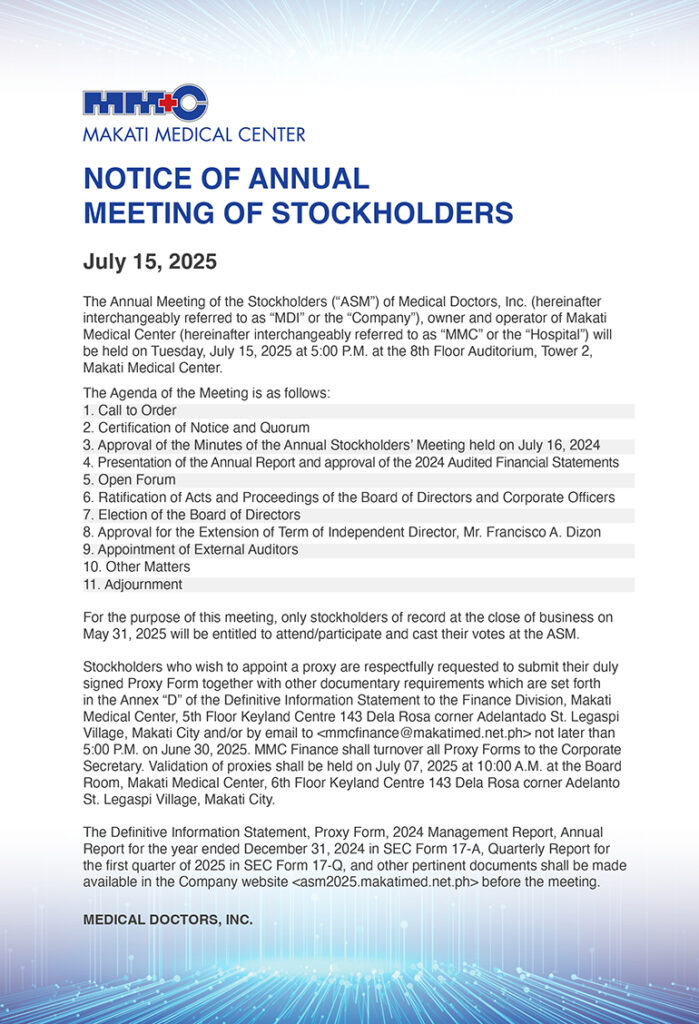
Spotlight is BusinessWorld’s sponsored section that allows advertisers to amplify their brand and connect with BusinessWorld’s audience by publishing their stories on the BusinessWorld Web site. For more information, send an email to online@bworldonline.com.
Join us on Viber at https://bit.ly/3hv6bLA to get more updates and subscribe to BusinessWorld’s titles and get exclusive content through www.bworld-x.com.


